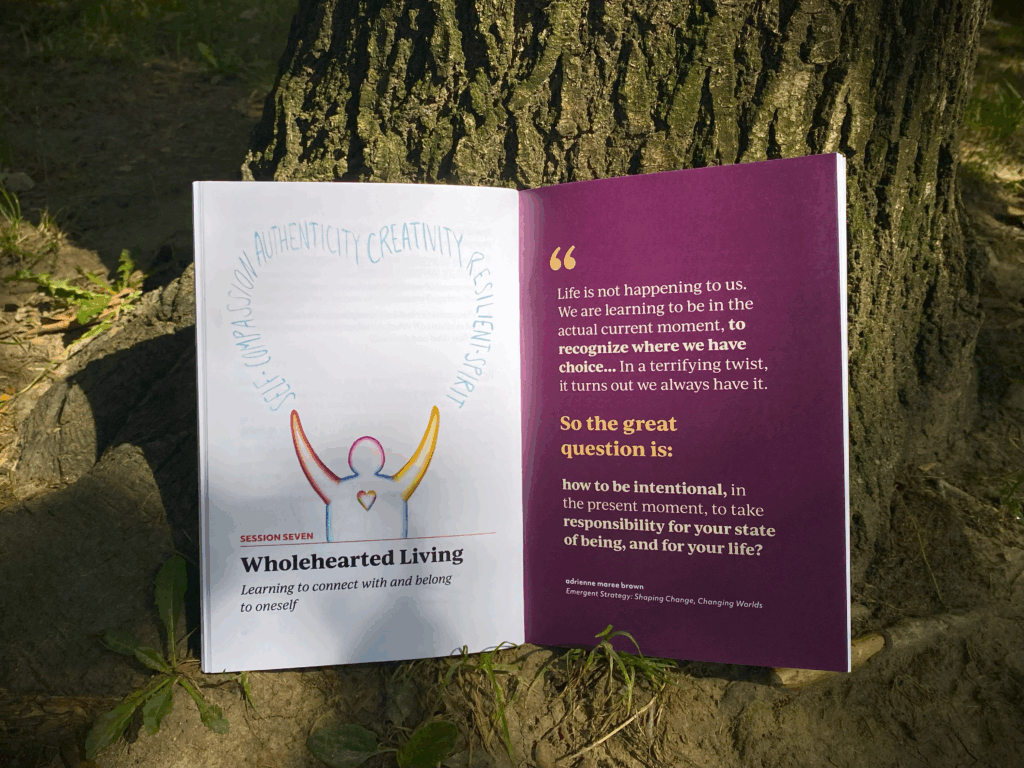This study is a spin-off of the Transitioning Youth Out of Homelessness (TYOH) 2.0 study—a community-based project that provided rent subsidies, one-on-one coaching, and a leadership guide to youth who had experienced homelessness. In that study, we tested our idea that coaching and a leadership guide could help increase identity capital (purpose, control, self-efficacy, and self-esteem). While the 12-month study had some promising findings, youth did not engage with the self-directed leadership guide as much as we had hoped.
Feedback from TYOH 2.0 participants was that the guide was a good idea; however, the self-directed learning felt overwhelming—especially given competing demands on their time—and a condensed curriculum worked through in a group setting might get better engagement. Our team really believed in the leadership guide because it had been co-developed with youth who had experienced homelessness, so we wanted to see if we could improve youth engagement before incorporating it into another study.
Co-Designing TYOH 2.5
Our team went back to the drawing board and co-developed TYOH 2.5—a four-week, in-person leadership program for youth transitioning out of homelessness. The team included three youth advisors (youth from a previous study), the two coaches from TYOH 2.0, and a Toronto-based high school teacher. The focus of the guide remained on increasing identity capital; however, we tried to make it more accessible and engaging by condensing the content and revamping the graphic design. We transformed the guide into a zine-sized booklet illustrated by Devin Brzozowski-Greenwood, a Niagara-based artist who is also one of our youth advisors.

The new leadership guide formed the foundation of the in-person leadership program, which consisted of eight 3-hour sessions held at public libraries over four weeks in Summer 2024. One program was held in St. Catharines and the other in Toronto. The program was facilitated by the two TYOH 2.0 study coaches with two of our youth advisors supporting as paid leadership interns (one coach and intern team per city).
What We Learned
Participants filled out questionnaires immediately before and after the program sessions. Lead researcher Dr. Naomi Thulien and research team member Mardi Daley—a peer engagement specialist with lived expertise of homelessness—also conducted focus groups with study participants at the end of the last session. Our main objective was to see if the leadership program was feasible and acceptable. Overall, we were happy with what we found:
- We enrolled 25 participants (our goal was 30)
- Most (72%) completed both data collection timepoints
- Average session attendance was 76% (approximately 6/8 sessions)
- The majority (84%) agreed or strongly agreed that the program made a difference in their day-to-day lives
We also found that self-esteem improved significantly at the end of the program compared to the beginning. There were no statistically significant changes in other measures of identity capital (purpose, control, and self-efficacy). Knowledge of program content improved from the beginning compared to end of the program on almost all (88%) of the questions. The questions showing the greatest improvement were related to building habits.
In the focus groups, young people shared that, even though they were housed, they were still primarily focused on survival. Because of this, it was hard to articulate goals beyond attaining and maintaining basic stability in their housing, school/work, and finances. Though many expressed a strong desire to break out of this pattern, they noted ineffective personal and professional supports and continued to have unmet practical needs.
Unfortunately, ongoing economic precarity is a common theme in all our studies when we explore the post-housing experiences of youth who have experienced homelessness. It is important to note that, in this small study, we did not provide additional supports such as rent subsidies like we usually do.
Young people in our study expressed varying experiences with the leadership program. For some youth, the program was yet another unsuccessful attempt at making change in their lives. Youth who did not feel that they got much out of the program told us they had heard similar content before. These youth described the program as repetitive activities of listening, reading, and writing that did not help them to apply new knowledge to their lives.
Other youth expressed a different perspective. These youth also referenced being familiar with the program content; however, they told us that group discussions with peers and individualized feedback from the coach helped them to newly internalize and apply what they knew. Young people described the link between self-awareness and agency—to feel they were making positive changes in their lives, they needed to become aware of their existing patterns and realize (either for the first time or again) where they had the power to make changes.
“I am glad that I came and got to put myself through this program. It just re-reminded me of who I was and I kind of had been staying away from that.”
“I feel like this program has helped me like figure out who I am, and it helped me figure out what I want to do in life, which is not what I expected coming in here.”
Next Steps
We are working with our youth advisors to iteratively improve the delivery of the leadership curriculum. Overall, we believe the in-person (vs. self-directed) format using the revised guide holds promise. We also saw the importance of having strong group facilitation skills—especially for youth who may come into the program with a healthy sense of skepticism—and offering youth tangible support for their immediate needs (like help with housing and employment). The curriculum has been re-titled Tools for Intentional Living, based on youth feedback that the term “leadership” did not resonate.
Since TYOH 2.5 wrapped up, our team has been co-developing the SEED CHANGE (Supporting Social & Economic Equity, Disrupting Cycles of Homelessness, And Nurturing Growth & Empowerment) study with our youth advisors and long-term community partners. SEED CHANGE builds on our previous research and will offer economic supports (money for rent and groceries; permanent employment), social supports (Community Connections Worker focused on connecting youth to meaningful relationships and activities), and identity capital supports (individual coaching; Tools for Intentional Living group program) for youth transitioning out of homelessness. The first 12 youth will begin the 18-month study in early 2026.

